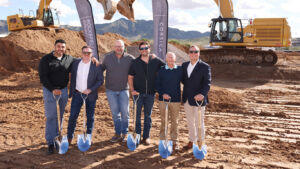If Q1 reports are any indication, the Phoenix metro’s industrial sector is suiting up for an interesting year. Intel finished construction on its 2.2MSF manufacturing fab in Chandler, Ariz. It sits vacant with hopes for adaptations into a manufacturing facility for chips.
The 700KSF Buckeye Business Center is under construction without any tenants. Last year, Turner Spectrum Ridge broke group on eight industrial buildings that totaled 120KSF of space in Deer Valley. And WinCo Warehouse is expected to complete a 800KSF distribution facility in Q2 2014. While there are a handful of tenants looking for large industrial spaces, a majority of market demand lingers between 20KSF and 100KSF.
Still, Phoenix ranks No. 3 in the country for year-over-year construction completion increases, according to Cushman & Wakefield’s Q1 2014 report. In Q1 2013, 316KSF of industrial product was completed. In Q1 2014, that number jumped to 2.1MSF. Another 2.7MSF is being developed. Industrial vacancy in Phoenix is at 10.5 percent, still above the national average (7.4 percent), Cushman & Wakefield reports. Vacancy reached a two-year high, reports Colliers International, and vacancy in buildings larger than 100KSF has spiked to 16 percent, while vacancy in buildings of 200KSF and larger has more than doubled in the past year to 17.6 percent.
“But the glass is half full,” says Marc Hertzberg, managing director of industrial/supply chain and logistics solutions at JLL. “Phoenix remains a great place for labor, lower operating costs and quality of life. Economic conditions are improving and we expect to bounce back.”
“Phoenix typically absorbs somewhere between 3.5MSF and 4.5MSF of industrial space per year,” says Hertzberg. “We’ve been off this mark for about 12 months now, but we are not the only market in this position. Our large-scale industrial sector is a mirror image of a phenomenon taking place in southern California, and particularly the Inland Empire, which usually absorbs as much industrial space in one quarter, approximately 4MSF, as Phoenix does all year. At almost mid-year, that market has only absorbed 3.4MSF.”
The sweet spot, he says, are the small- and mid-size users who need between 75KSF and 200KSF. “The small- and mid-size users are typically made up of higher-wage specialized employers like medical and high-tech companies,” Hertzberg says. “They are looking for fully-air conditioned flex industrial space that is close to quality labor, vendors and transportation, and they are willing to pay prices of approximately 10 to 20 percent higher than the big-box users in the areas of west Phoenix to secure those factors.”
Build-to-suit construction is what companies need to factor into their projections, says Hertzberg.
“In the build-to-suit sector, vertical markets like e-commerce and food and beverage are providing us with some positive absorption, however this does nothing to fill existing space,” he says. “Rather, it is adding specialized building inventory to our market—product that is built specifically for its user versus the specs of an existing warehouse.”
“We are seeing an aggressive level of capital looking to be placed in Phoenix,” says Cassidy Turley’s Industrial Group Vice President Will Strong. Companies are looking toward build-to-suit options over taking existing buildings, he says.
“New industrial developments are pushing higher on clear height, bigger on truck courts, and are continuing to find better, more efficient and modern ways to meet the tenants’ changing facility needs,” he says. “We are seeing companies increase employment density for fulfillment centers, which in-turn pushes the parking requirements higher than a traditional warehouse user would have.”
Spec is also being leased up. Coldwater Depot in Avondale, Ariz., the Trammel Crow-Clarion project, entered the market with 600KSF in spec development and leased out to Conn Appliances and SanMar Corp.
“Capital markets are really looking at Phoenix hard right now because they can’t find anything to buy in other markets that pencils out,” Strong says. “This has pushed investors to look not only at traditional listings but also off-market opportunities. Whether current owners will sell is another question. Some are contemplating offers, but even if they were to sell they’d need to determine where to put their money next, and if that investment has the same kind of upside potential as Phoenix industrial space.”



